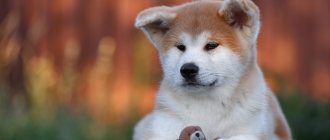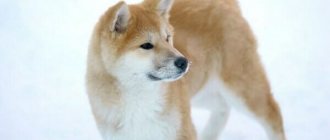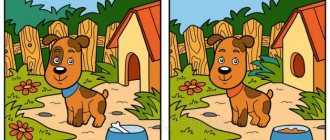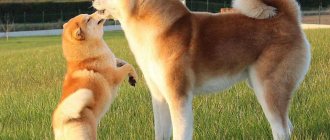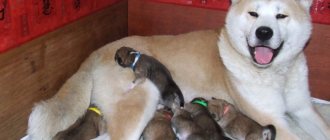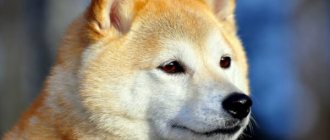History of the breed
The history of the Akita Inu is very interesting; this breed is one of the 14 oldest breeds in the world. These are not just words or legends, this fact was proven by scientists who studied the dog's pedigree in detail and conducted genetic research. Also, the antiquity of this breed is evidenced by the remains that were found on the territory of modern Japan and date back to approximately the 2nd millennium BC. In addition, ancient drawings were discovered depicting a dog very similar in appearance to the modern Akita Inu.
The Japanese decided not to waste a lot of time and imagination on coming up with an original name for the breed. Translated from Japanese, “inu” means “dog”, and “akita” is the name of a mountainous province in the northern part of the island of Honshu. The first dogs with a fully formed appearance appeared in that area back in the 17th century, and their appearance has remained unchanged to this day. They were favorite pets of the most influential statesmen, royalty and even emperors.
This is one of the few breeds that is truly “pure breed” without “admixtures” of new blood. Initially, the Akita was a favorite guard in peasant houses and an excellent hunter, but in the 18th century the dogs changed their class affiliation and became “elite”. A law was passed stating that a person who dared to offend or kill an Akita Inu would be subject to severe punishment. After some time, this breed was available only to members of the imperial family and the ruling aristocracy.
It is worth noting that this fact greatly affected the development of the breed as a whole. Keeping, feeding and caring for an Akita has become a special ceremony. Each dog had its own personal servant, and special leashes and collars were made for them, by which the rank of the dog and the social status of its owner could be determined. Everything around had to correspond to the respect that the Akita enjoyed.
In 1927, the Akita Inu Preservation Society was created. This was done in order to preserve the pure breed and to prevent the Akita from being crossed with other dogs. During World War II, most Akita Inus were sent to the front for military use. In those days, Akita breeding stopped a bit due to lack of food and funds for maintenance. In Japan, only a few purebreds were preserved, but despite this, the breed survived the post-war period and managed to retain all its natural qualities.
It is believed that the ancestor of the Akita was a Chinese Spitz dog mixed with mastiff blood. There is also another theory that the beautiful Akita was created by mixing a Siberian Husky and a Mastiff. Although the Akita is somewhat similar to the Russian Laika, they have nothing in common.
In the 19th century, a huge number of other breeds poured into Japan (Great Danes, Bulldogs, St. Bernards). The Japanese wanted to create a more aggressive breed that could protect not only their family, but also their property. Today it is impossible to say for sure that inbreeding somehow influenced the appearance and characteristics of the Akita, but thanks to these crossings, breeds such as the Karafuto and Tosa Inu appeared. Over the past 50 years, the Akita Inu has also changed a little, with a more powerful and dense build, as well as more aggression and temperament.
Intelligence
The Japanese Akita Inu dog breed has a lively and developed mind - its representatives can control their behavior depending on the situation, are capable of cunning and independent decision-making. The intellectual abilities of these Japanese smart dogs allow them to be both extroverts and very thoughtful dogs who do not always show their emotions - no matter whether it is joy or some sadness. In these manifestations, the Akita Inu's character is surprisingly reminiscent of the classic Japanese samurai. In difficult situations, the dog does not lose its dignity.
A detailed description of the Akita Inu emphasizes all the advantages of the Japanese breed. Each representative of this tribe is not only an extremely loyal, brave and sociable animal, but also a wise pet who will always support the owner in difficult times. There are legends about the devotion of Akitas, the story of the legendary Hachiko is further proof of this.
It is known that the memory of Japanese Akita Inu dogs is one of the most developed and accurate dogs in the world. Samurai remember not only commands, words and facial expressions of a person, but also the details of their life, down to what they ate for lunch on a certain day exactly a month ago. They independently build their emotional cycles, adapting them to the life circumstances of their owners. Believe me, they are not guided by instincts. Many experts claim that dogs of the Hachiko breed, which were born in a kennel and then bought by ordinary people, thoroughly remember their first breeders, as well as their mother, brothers and sisters.
Character
The character of the Akita Inu has been formed over thousands of years. At first they were hunting dogs, then - guards of luxurious aristocratic palaces and bodyguards. As a result of the change in specialization and vocation, Akitas acquired new qualities without losing the old ones. In addition, the reverent attitude towards them on the part of the owners allowed these dogs to understand human psychology. The behavior pattern of Akitas cannot be called typical (especially in comparison with European and American breeds). They are very playful as children, but as they grow older they acquire an incredible amount of wisdom that allows them to be both sincere and reserved.
It would seem that the character of Akitas is built on mutually exclusive paradoxes. For example, one of the key aspects of the behavior of these dogs is independence and willfulness. They love to walk without a leash, choose their own places to sleep in the house, and can even suddenly disappear somewhere for several hours. And here the second aspect comes into play: Akitas become very attached to their home and owners, always returning to their home door. Their instincts allow them to reliably protect everything that is most important in their life - home and family. Thanks to high-quality selection, the Akita Inu dog breed is ideal for home guarding. At the same time, these dogs are wonderful companions and just cute, smart pets. The main rule that the owner of an Akita must remember: this Japanese dog is equal to you. She does not need excessive tenderness and unnatural displays of attention. She appreciates your sincerity, but does not recognize your condescending attitude towards her. When you go for a walk together, you are not “walking” the Akita, but walking with him like best friends.
Akita Inu character
Dogs have a calm temperament, are friendly and have high intelligence. The dog demands respect and strives to become a leader in the family. The dog needs to be made clear that the “leader” is the person. After this, the animal will become obedient and submissive and will remain devoted to its owner for the rest of its life.
The animal gets along well with children and pets. The dog is very curious, it actively explores the surrounding space and strives to help its owners in all family matters. The Akita Inu is suspicious of strangers and can be aggressive towards those who try to violate its territory. During an attack, the animal shows courage and behaves fearlessly. Akita Inus do not tolerate loneliness well. Dogs lose their appetite and become depressed.
Socialization
Akita Inu are sociable dogs that get along easily with other pets in the house. Especially if the animals grew and developed together - in this case, your Maine Coon or Siberian cat will be the samurai's best friends.
But Akitas can treat dogs on the street with aggression and a desire to dominate. They are especially nervous about small, vocal dogs.
Akitas receive apartment guests calmly and quite politely, but at the same time they behave somewhat distantly and coldly. In this way (hiding emotions and showing indifference), the Akita Inu masks its interest in the new person. The fact is that hunting and guard instincts force the dog to be careful, carefully watch and study the stranger.
When it comes to playing with children, Akitas forget about their samurai restraint and return to childhood. They can spend time with the kids for as long as possible, showing joy, kindness, patience and attentiveness. Seeing an Akita Inu in a photo with a child is not at all uncommon. It is known that Japanese aristocrats often used Akitas as nannies for their children.
Care and maintenance
Despite the luxurious coat, too much grooming is not required. Every week you need to thoroughly comb it with different types of combs and brushes. Only twice a year, when shedding occurs, the procedure is repeated much more often - every other day to help the pet get rid of heavy dead hair.
Ideally, it is better to keep them in an outdoor enclosure; all you need is a comfortable closed booth. Domestic dogs have less freedom and also require two walks a day. They do not need to be bathed often; Akitas are clean from birth. A couple of times a year using special shampoos is quite enough.
Cutting your hair is not recommended at all. In addition to grooming, you need to brush your teeth every 3-4 days and trim your nails 1-2 times a month. Overall this is a healthy breed. However, there is a predisposition to certain types of diseases:
- Joint dysplasia. It is transmitted genetically, such dogs are rejected and taken out of breeding.
- Eversion of the century. They can only be corrected surgically.
- Gastric volvulus. Not a hereditary disease. May occur from excess weight and lack of exercise. As a preventive measure, you need to keep an eye on the amount of food you eat and plan your diet wisely.
Education
Despite the understanding and developed intelligence of Japanese dogs, Akita Inu training is sometimes difficult. You need to raise little samurai in a measured manner and without overwhelming intensity. Remember, overwork never improves learning efficiency.
Akitas mature very slowly. As a rule, psychology, character and value system are finally formed only by the age of two. If you want this dog to become an ideal pet, then remember: playing with your puppy should not be aggressive. Pets of the Hachiko breed have a very strong and independent character, so if at an early age you teach her to be aggressive, then as she grows up, your dog will turn into a dangerous monster.
Training, which allows our hero to be extremely disciplined, but aggressive and tenacious at the command of the owner, can only be carried out by professionals. It is not for nothing that Akitas still successfully serve in the Japanese police.
Akitas are very temperamental. A relaxed, happy appearance can suddenly give way to fussy playfulness. But usually, adult Akitas clearly understand when it’s okay to have fun and go a little crazy, and when not. A properly trained Japanese dog will never get on his owner's nerves.
Feed
The basis of the diet of these dogs in their homeland, Japan, is rice, fish and seafood, seaweed, and vegetables. Purebred Akitas are adapted specifically to this diet. They very often have an allergic reaction to chicken, beef, fatty dairy products, wheat, corn and oatmeal. To feed puppies of the Japanese dog Hachiko, you should stock up and always have boiled sea fish, low-fat cottage cheese, veal, fruits and vegetables at the ready. It is difficult for an adult dog to choose suitable dry food, since the soy contained in ready-made mixtures is poorly digestible by Akitas. It is optimal to stick to food that has only one source of protein - fish or duck. The protein proportion should be a maximum of 26%.
Walking and exercise
Akita Inus easily get used to life at home and do not feel any discomfort even in small apartments. Of course, only under one condition: they need regular walks and physical activity.
The Akita Inu dog breed is distinguished by its athletic build. The muscular and dense body structure is a kind of extension of their intelligence and character. Correct psychology and education are impossible if the Akita is in poor shape - the Japanese dog must be smart and fast. The optimal walking regimen is two hour-long walks in the morning and evening. If work or other matters do not allow you to devote so much time to your pet, then one of the walking sessions can be shortened and the gap filled on the weekend.
The independence and willfulness of Akitas is often reflected in their physical form - they really like to run around in the open air without a collar. Be sure to take this into account when choosing a suitable place for walking. The Japanese Akita Inu dog breed has been developed in similar conditions for centuries, so this dog should receive this opportunity at least once a week.
Samurai are always happy to play, but they quickly get bored with the same type of fun. In this case, they are very similar to huskies and other northern breeds. The owner needs to be creative, often changing the game equipment, locations and intensity of useful entertainment. It is advisable that the places where you play and walk your Akita have different types of soil. This promotes a balanced load on all muscle groups.
Features of maintenance, care, health
Caring for an Akita Inu dog is quite simple. The dog is perfectly suited for being kept both outdoors and in an apartment. However, “apartment” Akitas need to be walked at least twice a day. When walking, adult Akitas behave inactively - they calmly walk next to their owner, but they will not refuse to play or fight with their relatives.
It is enough to comb the wool once a week. During the shedding period, to help your dog get rid of old fur, brush your pet 2-3 times a week. You need to bathe your dog as rarely as possible, only a few times a year. For washing, use only special shampoos for dogs.
The optimal diet for Akita Inu is well-selected dry food. It contains all the vitamins and minerals your pet needs. Provide your animal with constant access to clean and fresh water. During shedding, it is recommended to add nutritional supplements to your dog’s diet that have a positive effect on the condition of the coat.
Training and raising an Akita will require a lot of time and patience. Due to their willful and proud nature, Akitas are not able to carry out commands with lightning speed, hence their certain slowness. However, the worst mistake would be to use physical force or shouting to achieve results. Once, by yelling at a dog or hitting it, you risk making an enemy who will definitely take revenge on you at the first opportunity.
It is important to remember the fighting past of Akita Inu dogs. Your pet's behavior can become unpredictable if you don't lay the foundations for proper behavior in time. By raising a dog from childhood and positioning yourself correctly, you will avoid many problems in the future. Akita Inu is very obedient and will never go against the will of its owner, but only if it recognizes him as the “leader”.
Akita Inu do not accept excessive tenderness. Despite his love for children, a dog can react aggressively to a child who pulls his tail or paws. Dogs of this breed strictly guard the territory entrusted to them and are excellent watchmen and security guards. They almost never bark, but simply silently attack an enemy who has violated the boundaries of their property. By nature, the Akita Inu is a predator, so you should not once again awaken aggression in the dog. Do not allow fights with other dogs, do not set your pet on fire.
Nutrition
There are no special whims in nutrition, the main rule is not to give food from your table. Everything fatty, salty, sweet, spicy, fried and smoked should never end up in her bowl. Almost all representatives have a love for boiled fish, you just need to choose the bones. It is best to develop a diet in consultation with a professional.
The simplest way is factory-made high-quality food, it is already balanced with all the necessary additives. A couple of times a week you need to add cottage cheese, kefir or yogurt, a piece of lean meat, boiled vegetables with broth and boiled sea fish. There should always be fresh water in the second bowl. At the time of shedding, vitamins are added to the food for coat growth.
Pet training
Akita training deserves close attention and attention, since it simply cannot be done without it. Akita Inu has serious muscles that need to be developed day by day. From the age of six months, you can take your puppy to a dog training area. Of course, he won’t immediately start following commands and exercises, but he will run around interesting devices and slides with interest.
Akita is a very intelligent dog with a playful and good-natured disposition. She is easy to train due to her curiosity and thirst for physical activity. Owners can be sure that their pet will withstand any stress and testing, since it is difficult to find an animal with greater endurance and stubbornness. Some continue to use this breed for hunting, but this is not common. Due to its popularity, Akita Inu is most often kept in apartment conditions. But, despite the animal’s place of residence, it is necessary to carry out daily training and long walks.
As soon as the dog has crossed the threshold of the apartment, it will imposingly begin to inspect the territory. Any item on the floor will be subject to thorough testing, both for smell and taste, so everything should be removed. Under no circumstances should you hit a puppy. He will leave nothing but anger in his memory.
If the puppy has misbehaved, you need to use a threatening tone to indicate that he was wrong, and this should be done immediately after the offense. Young dogs have a very short memory, so if you punish the dog after half an hour, it simply will not understand why it was reprimanded.
Choosing a puppy
You should not buy an Akita Inu puppy at the bird market. Before purchasing a puppy, it is necessary, if possible, to “get to know” the parents and study their documents. It is best to contact the breed club. When choosing a breeder, keep in mind that there are many clubs not recognized by the International Canine Organization that do not guarantee high-breed dogs.
A puppy from a large litter would not be the best choice. Don't grab the biggest puppy, because big doesn't mean the best. An excellent option is a puppy from an even litter, in which the brothers and sisters do not differ much from each other in size.
A healthy puppy is moderately well-fed and has shiny coat. He is cheerful, cheerful and inquisitive, stands firmly on his feet and is confident in his movements. A puppy with a healthy psyche should not be afraid of sudden loud sounds or be overly aggressive. Pay attention to the bite, pigmentation of the nose and mouth, eye color. In male dogs, both testicles should be descended into the scrotum.
If you are purchasing an Akita Inu puppy only as a pet, follow these criteria and rely on your intuition. When choosing a dog for participation in exhibitions or breeding, it is better to involve a specialist dog handler who will help you determine the future champion.
Habits and character
Having a purebred animal in your home is a lot of positive emotions. A young family who has not had such experience can start with this breed. Only at the beginning it is important to learn a lot of useful information about the Akita Inu - the character of the dog and the features of its psychology. They are subtle manipulators.
The dog, who from the first days was not shown who the “leader of the pack” is, will try to take this place. He can be mischievous and self-willed, running away during walks if his walking is entrusted to someone else outside a spacious enclosure or fenced area.
Representatives of this selection are quite compatible with small children and elderly people. They are active and independent, adapting well to the lifestyle of their owners and family members. But they need a personal space where they can calmly rest from the intrusive attention of children or frequent guests.
Well-bred Akita Inus behave quite decently in an apartment. They look independent, but need companionship and active training. Don't expect more than these animals can give to their lucky owners. The wrong idea is formed by funny videos, heart-warming films or funny photos of Akita Inu puppies.
Akita Inu breeding and price
Since the Akita Inu is a breed of late development, and adulthood begins only at 2 years, mating should begin no earlier than the bitch’s 3rd heat. If the dog is healthy and has no significant changes in standards after selection, then the pregnancy and birth should go well. On average, a litter of an adult bitch consists of 4-6 puppies. Although this breed is characterized by multiple pregnancies with 8-14 puppies in the litter. Akita pregnancy lasts from 57 to 62 days.
An Akita Inu should be bred either by a professional and expert, or by a competent beginner, but with the help of a professional and experienced breeder. If an illiterate amateur decides to enrich himself by breeding an Akita, then you should know that this matter is practically hopeless and threatens failure. After all, the price for a healthy purebred puppy is quite high - from 70 thousand rubles and above . Potential buyers are scared by just one number. Plus, many are alarmed by the difficulties with upbringing and training, and they are not entirely pleased with the “unremarkable” appearance of the dog.
Akita Inu varieties
Representatives of the breed are divided into 2 main types:
- Japanese Akita Inu.
- American Akita (a cross between a classic breed and large Molossians).
Dogs bred by American dog breeders have a characteristic black “mask” on their heads. “Americans” have a heavy body type, are silent and adapt well to low temperatures. Animals serve in law enforcement agencies and security agencies. The dog's weight can reach up to 60 kg.
Legendary Hachiko
Hachiko
In 1932, an Akita Inu named Hachiko became famous throughout Japan. Hachiko met the owner every day when he returned from work by train. One day the owner died at work, but the dog waited for him at the station for several hours. For 9 years after the death of the owner, the dog came to the station at the same time and waited for his return from work. A monument was erected to Hachiko, at the opening of which he was personally present. After his death, due to the wide resonance, a day of mourning was declared in the country. During World War II, the monument was destroyed - the metal of the monument was used for military needs. But Japan did not forget the dog, and after the end of the war, in August 1948, the monument was restored. Today, the statue of Hachiko at Shibuya Station is a meeting place for lovers, and the very image of the dog in Japan has become an example of selfless love and loyalty. Hachiko's story was the basis for the 1987 film The Story of Hachiko and the 2009 remake Hachiko: A True Friend starring Richard Gere.
Video
Interesting Facts
- The dog has a specific “smiling” mouth structure. It seems to people around that the animal is constantly happy about something.
- In 1931, Akita Inu was declared a natural monument.
- The Akita Inu's coat does not smell like a dog.
- In Japan, it is customary to give a figurine of an Akita Inu to new parents.
- The animal was used for hunting large animals (boar, elk, bear, etc.).
- The Japanese government gives Akita Inu dogs to foreign citizens as a sign of special gratitude. In 2012, Vladimir Putin received a “furry gift”. Thus, the Japanese thanked the Russian President for his assistance in eliminating the consequences of the earthquake.
- The word "inu" means "dog" in Japanese.
- If a dog takes first place at an international exhibition, then all expenses for its further maintenance are borne by the Japanese government.

